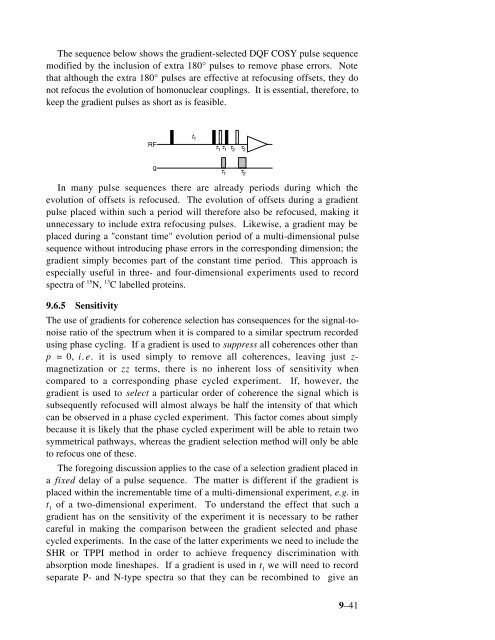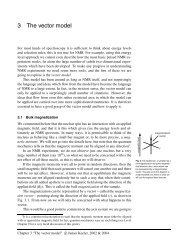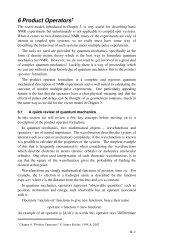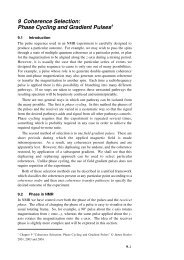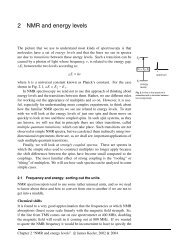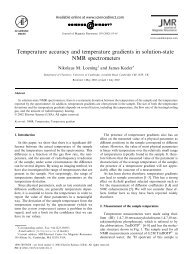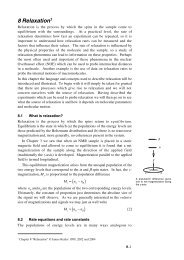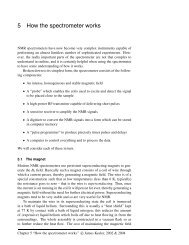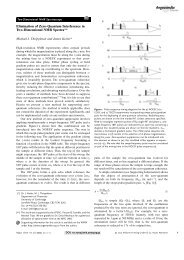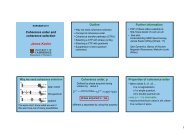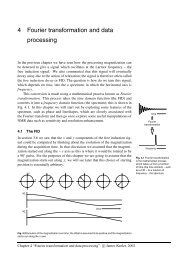Phase Cycling and Gradient Pulses - The James Keeler Group
Phase Cycling and Gradient Pulses - The James Keeler Group
Phase Cycling and Gradient Pulses - The James Keeler Group
Create successful ePaper yourself
Turn your PDF publications into a flip-book with our unique Google optimized e-Paper software.
<strong>The</strong> sequence below shows the gradient-selected DQF COSY pulse sequence<br />
modified by the inclusion of extra 180° pulses to remove phase errors. Note<br />
that although the extra 180° pulses are effective at refocusing offsets, they do<br />
not refocus the evolution of homonuclear couplings. It is essential, therefore, to<br />
keep the gradient pulses as short as is feasible.<br />
t 1<br />
1<br />
RF<br />
τ1<br />
1<br />
τ2<br />
τ 2<br />
τ 2<br />
g<br />
τ<br />
τ<br />
In many pulse sequences there are already periods during which the<br />
evolution of offsets is refocused. <strong>The</strong> evolution of offsets during a gradient<br />
pulse placed within such a period will therefore also be refocused, making it<br />
unnecessary to include extra refocusing pulses. Likewise, a gradient may be<br />
placed during a "constant time" evolution period of a multi-dimensional pulse<br />
sequence without introducing phase errors in the corresponding dimension; the<br />
gradient simply becomes part of the constant time period. This approach is<br />
especially useful in three- <strong>and</strong> four-dimensional experiments used to record<br />
spectra of 15 N, 13 C labelled proteins.<br />
9.6.5 Sensitivity<br />
<strong>The</strong> use of gradients for coherence selection has consequences for the signal-tonoise<br />
ratio of the spectrum when it is compared to a similar spectrum recorded<br />
using phase cycling. If a gradient is used to suppress all coherences other than<br />
p = 0, i.e. it is used simply to remove all coherences, leaving just z-<br />
magnetization or zz terms, there is no inherent loss of sensitivity when<br />
compared to a corresponding phase cycled experiment. If, however, the<br />
gradient is used to select a particular order of coherence the signal which is<br />
subsequently refocused will almost always be half the intensity of that which<br />
can be observed in a phase cycled experiment. This factor comes about simply<br />
because it is likely that the phase cycled experiment will be able to retain two<br />
symmetrical pathways, whereas the gradient selection method will only be able<br />
to refocus one of these.<br />
<strong>The</strong> foregoing discussion applies to the case of a selection gradient placed in<br />
a fixed delay of a pulse sequence. <strong>The</strong> matter is different if the gradient is<br />
placed within the incrementable time of a multi-dimensional experiment, e.g. in<br />
t 1<br />
of a two-dimensional experiment. To underst<strong>and</strong> the effect that such a<br />
gradient has on the sensitivity of the experiment it is necessary to be rather<br />
careful in making the comparison between the gradient selected <strong>and</strong> phase<br />
cycled experiments. In the case of the latter experiments we need to include the<br />
SHR or TPPI method in order to achieve frequency discrimination with<br />
absorption mode lineshapes. If a gradient is used in t 1<br />
we will need to record<br />
separate P- <strong>and</strong> N-type spectra so that they can be recombined to give an<br />
9–41


